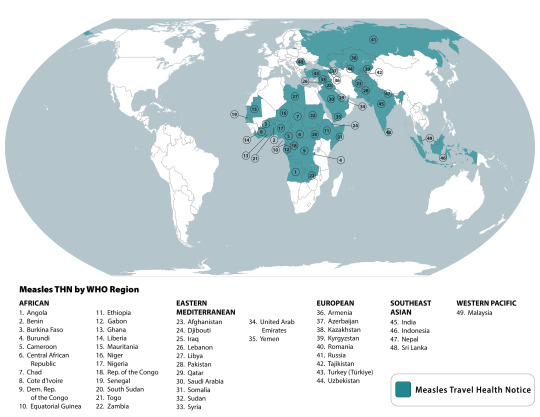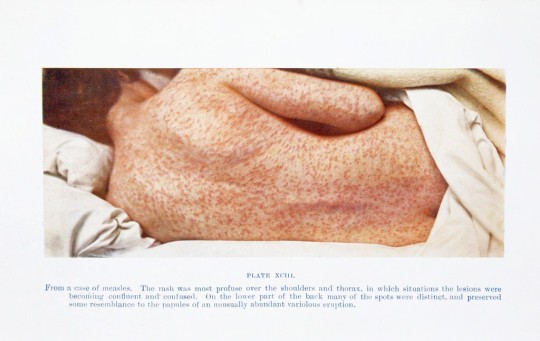Text
Let Erin Welsh and Erin Allman Updyke tell you about the history and epidemiology of measles over at This Podcast Will Kill You. Listen on your favorite podcast app!
#TeachingRounds#FOAMed#microbiology#virology#epidemiology#medical history#vaccine preventable disease
1 note
·
View note
Text
Parents who will travel to hotspots with babies 6-11 months should give a measles vaccine before going. Due to the immaturity of their immune systems, they will still need the 2 usual shots at 1 and 4 years old.
If the child is at least 12 months old, they should get 2 shots 28 days apart with 2 weeks left before they travel.
#TeachingRounds#FOAMed#public health#pediatrics#infectious diseawes#vaccines work#vaccine preventable disease#travel health
1 note
·
View note
Text
Q. Where in the world is there measles?
A. It's not just the United States: the United Kingdom, the Philippines, and Austria (among other countries) are experiencing measles outbreaks.

#TeachingRounds#FOAMed#public health#epidemiology#pediatrics#vaccine preventable disease#infectious disease
2 notes
·
View notes
Text
Q. Why is there a measles outbreak in the United States right now?
A. The current measles outbreak in the United States is due in part to the fact that in 36 states, <95% of kindergartners are fully vaccinated with
1 dose of MMR vaccine at 12-15 months AND
1 dose of MMR or MMR-varicella at 4-6 years
2 shots provides 97% personal protection.
1 note
·
View note
Text
How big is the current measles outbreak in the United States?
Although measles was declared eliminated in the United States in 2000, outbreaks resulting from imported cases by unvaccinated children continue to occur. "As of April 4, 2024, a total of 113 measles cases were reported by 18 jurisdictions: Arizona, California, Florida, Georgia, Illinois, Indiana, Louisiana, Maryland, Michigan, Minnesota, Missouri, New Jersey, New York City, New York State, Ohio, Pennsylvania, Virginia, and Washington."
The US saw 58 cases of measles in all of 2023.
#TeachingRounds#FOAMed#microbiology#epidemiology#infectious diseases#pediatrics#vaccine preventable disease
2 notes
·
View notes
Text
Q. What are the possible complications from measles (rubeola)?
A. According to the CDC, complications from measles infection include
- hospitalization (1:5 unvaccinated individuals)
- otitis media (1:10)
- pneumonia (1:20)
- encephalitis (1:1000)
- death (1-3:1000)
- subacute sclerosing panencephalitis (SSPE) is a delayed neurodegenerative disorder of personality changes, seizures, coma, and death ~10-11 years after infection
0 notes
Text
Q. Do you recognize this rash?

A. Measles (rubeola) is an infectious disease caused by a single-stranded Paramyxoviridae RNA virus. After infection, the virus incubates for ~10 days. First come fever, congestion, conjunctivitis, and a highly infectious "barking" cough that spreads respiratory droplets. 3-4 days later a rash appears. All symptoms intensify for 3-4 days and then resolve. Late winter and spring is prime time for measles infections.
Source: Craft, Fox, Goldsmith, "Measles in Child"; image from Wellcome Collection
5 notes
·
View notes
Text

If you'd like to read more about the events that inspired Doctors Day, pick up J.M. Fenster's entertaining Ether Day: The Strange Take of America's Greatest Medical Discovery and the Haunted Men Who Made It.
1 note
·
View note
Text

Happy National Doctors Day!
5 notes
·
View notes
Text

The U.S. House of Representatives passed the first resolution for Doctors Day in 1958, and in 1990, Present George H.W. Bush made it a national non-bank holiday.
2 notes
·
View notes
Text

Red carnations are used on National Doctors Day (March 30) to represent sacrifice, charity, courage, bravery and love.
2 notes
·
View notes
Text

Eudora Brown Almond chose to celebrate Doctors Day on March 30, the date in 1842 when fellow Georgian Dr. Crawford Long used ether as a surgical anesthetic for the first time. However, #EtherDay is celebrated on October 16, the anniversary of Dr. Charles Morton's public demonstration of ether at Harvard in 1846.
0 notes
Text

National Doctors day was founded in 1933 by the wife of family medicine physician Dr. Charles B. Almond. Eudora Brown Almond encouraged folks to send a card to their doctor(s) and to lay flowers on the graves of those who had died, such as local celebrity Dr. Crawford Long (1815-1878).
Do you know what he was famous for?
Image credit: Wilmington StarNews
1 note
·
View note
Text

National Doctors Day is March 30. This year’s theme, “Wings & Stethoscopes: Healers of Hope,” reflects the idea that doctors selflessly and tirelessly work to lift up America’s families through two powerful symbols. The first is the ubiquitous stethoscope hanging from the shoulders of doctors, ready to spring into action. The second symbol is the caduceus*, two snakes winding around a winged staff in a nod to Asclepius, the Greek god of healing and medicine.
*Actually, Asclepius's rod had only one snake; the winged, two-snake caduceus is Mercury's symbol.
2 notes
·
View notes
Text
Thanks to public health measures for SARS-CoV-2, the B Yamagata strain of influenza B has not circulated since March 2020. Therefore, flu vaccines will be trivalent (2 A strains + B Victoria) starting with the 2024-2025 flu season.
0 notes
Text

DID YOU KNOW...?
Since 2023, NO influenza shot is made with eggs! However, the nasal spray still is. It is approved for non-pregnant people 2 years and older who are not immunocompromised.
0 notes
Text
Q. Why should you get a flu shot every year?
.
.
.
.
.
A. Because influenza is a public health nightmare: although 25% of cases are asymptomatic, it is very contagious and transmittable during its incubation period (ie. before the host knows s/he is sick). Human flu is a combination of swine and animal flus whose 8 genes easily recombine, so the vaccine has to be remade every year. Flu vaccination reduces the severity of any infection that does take hold AND transmission to babies <6 mo. (no approved vaccine).
This year's shots have been 60-65% effective in preventing outpatient visits and 55-60% effective in preventing hospitalization.
0 notes